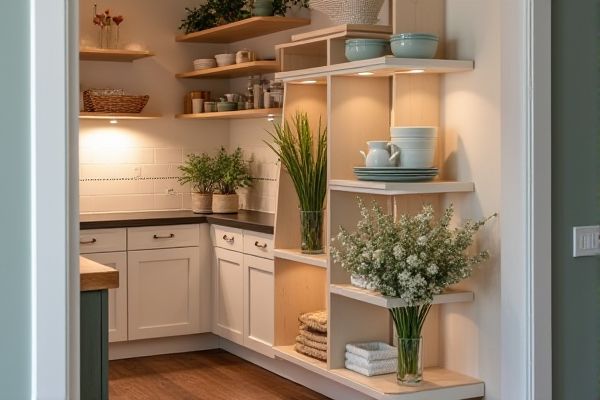
Pull-out vertical racks maximize space by utilizing the height of cabinets, offering easy access to items stored in narrow, deep spaces, whereas horizontal racks provide a more traditional layout with shelves arranged side-by-side, ideal for wider storage areas. Discover which rack system best suits Your kitchen design and storage needs by reading the rest of our detailed comparison.
Table of Comparison
| Feature | Pull-Out Vertical Racks | Horizontal Racks |
|---|---|---|
| Design | Vertical alignment with pull-out mechanism | Horizontal alignment with stationary shelves |
| Space Efficiency | Maximizes vertical space, ideal for narrow areas | Requires wider footprint, best for broad spaces |
| Accessibility | Easy access via pull-out, reduces item damage | Items accessed from front or top, less flexible |
| Weight Capacity | Moderate load capacity depending on mechanism | Generally supports heavier loads |
| Installation | Complex due to moving parts and guides | Simple, fixed installation |
| Maintenance | Requires regular checks of sliding mechanism | Low maintenance |
| Use Case | Ideal for small, high-density storage needs | Best for bulk storage and heavy-duty items |
Introduction to Pull-Out Vertical and Horizontal Racks
Pull-out vertical racks maximize space by utilizing vertical storage, ideal for narrow areas and easy access to items. Horizontal racks offer wider, flat storage surfaces, providing stability for large or heavy objects and simpler visibility across stored items. Choosing between vertical and horizontal racks depends on your spatial constraints and the nature of stored goods to optimize organization and efficiency.
Key Differences Between Vertical and Horizontal Racks
Vertical racks maximize vertical space by storing items upright, ideal for narrow areas and quick access, while horizontal racks spread items out horizontally, providing easier visibility and organization for wider spaces. Your choice depends on the type of inventory, with vertical racks suited for long or thin products like pipes and boards, whereas horizontal racks accommodate bulky items such as boxes and pallets. Load capacity and accessibility vary, as vertical racks often allow higher stacking but may limit individual access compared to the more accessible layout of horizontal racks.
Space Efficiency: Which Rack Saves More Room?
Pull-out vertical racks maximize space efficiency by utilizing vertical storage areas often underused, allowing you to store taller items without encroaching on floor space. Horizontal racks, while easier to access, require more floor or shelf depth, reducing overall storage capacity in compact environments. Choosing vertical racks optimizes room usage, especially in kitchens or warehouses with limited square footage.
Accessibility and Ease of Use Comparison
Pull-out vertical racks provide superior accessibility by allowing users to view and reach items at eye level, reducing the need to bend or stretch. Horizontal racks often require more effort to access items placed deeper within, limiting ease of use for frequently accessed goods. Vertical pull-out designs enhance organizational efficiency and ergonomics, making them ideal for rapid retrieval and minimizing physical strain.
Installation Requirements for Each Rack Type
Pull-out vertical racks require precise wall anchoring and additional space for full extension, demanding sturdy support structures and clearance for vertical movement. Horizontal racks generally need robust floor mounting and sufficient lateral space for easy access to stored items without obstructing aisle pathways. Your installation choice should consider structural support, space availability, and workflow efficiency to optimize storage usability.
Durability and Maintenance Considerations
Pull-out vertical racks typically offer enhanced durability due to their robust sliding mechanisms and space-saving design, reducing wear from frequent handling compared to horizontal racks. Horizontal racks may require more frequent maintenance as items are accessed more directly, increasing the risk of damage to rack components and stored products. Your choice should consider the maintenance demands and lifespan benefits suited to your storage environment.
Safety Features: Vertical vs. Horizontal Storage
Pull-out vertical racks offer enhanced safety features by minimizing the risk of items falling during retrieval, as contents are stored upright and secured within enclosed vertical columns. Horizontal racks, while allowing easier access to items laid flat, can pose greater hazards with heavier objects shifting or falling if not properly restrained. Vertical racks also improve ergonomic safety by reducing the need to reach or bend excessively, lowering the chance of strain injuries.
Ideal Applications for Vertical and Horizontal Racks
Vertical pull-out racks are ideal for storing long items like brooms, mops, or cutting boards in narrow kitchen spaces, maximizing vertical space and improving accessibility. Horizontal racks suit stacking flat items such as baking trays, pans, or plates, providing easy visibility and access in wider drawer spaces. Your choice depends on the shape and size of stored items, with vertical racks optimizing height and horizontal racks enhancing lateral storage efficiency.
Cost Analysis: Initial Investment and Long-Term Value
Pull-out vertical racks generally demand a higher initial investment due to advanced mechanisms and space-saving design, contrasting with horizontal racks which often feature simpler, cost-effective construction. Long-term value of vertical racks is enhanced by maximizing vertical storage density, reducing floor space requirements, and improving accessibility, leading to operational efficiency and potential labor cost savings. Horizontal racks may have lower upfront costs but can result in higher spatial expenses and less optimized inventory management over time, impacting overall return on investment.
Choosing the Right Rack for Your Needs
Pull-out vertical racks maximize space efficiency by utilizing height, making them ideal for small or narrow kitchens where floor space is limited, while horizontal racks offer easier access and visibility for larger or wider storage areas. Your choice depends on the kitchen layout and the type of items you need to store, with vertical racks excelling in compact storage and horizontal racks providing more straightforward organization. Assess your storage needs and kitchen design to determine whether a pull-out vertical or horizontal rack will optimize accessibility and space utilization.
 homyna.com
homyna.com